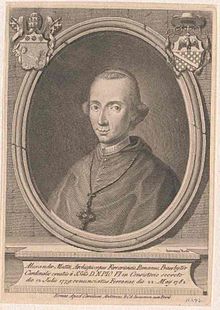
KNOWPIA
WELCOME TO KNOWPIA
Summary
Alessandro Mattei (20 February 1744, Rome – 20 April 1820) was an Italian Cardinal, and a significant figure in papal diplomacy of the Napoleonic period. He was from the Roman aristocratic House of Mattei.
His Eminence Alessandro Mattei | |
|---|---|
| Cardinal-Bishop of Ostia e Velletri | |
 | |
| See | Ostia e Velletri |
| Appointed | 26 September 1814 |
| Term ended | 20 April 1820 |
| Predecessor | Leonardo Antonelli |
| Successor | Giulio Maria della Somaglia |
| Other post(s) | Archpriest of Saint Peter's Basilica |
| Orders | |
| Ordination | 27 February 1768 |
| Consecration | 23 February 1777 by Bernardino Giraud |
| Created cardinal | 12 July 1779 |
| Rank | Cardinal-Bishop |
| Personal details | |
| Born | 20 February 1744 |
| Died | 20 April 1820 (aged 76) |
| Denomination | Roman Catholic |
| Previous post(s) |
|
He became Archbishop of Ferrara in 1777, and was named cardinal in 1779.
He became Bishop of Palestrina in 1800, Bishop of Porto-Santa Rufina in 1809, and Bishop of Ostia in 1814.[1] From 1817 to his death he was archpriest of St Peter's Basilica.
Episcopal succession edit
Ordination history of Alessandro Mattei | |||||||
|---|---|---|---|---|---|---|---|
| |||||||
| |||||||
Cardinal Bernardino Giraud consecrated Mattei to the episcopacy on 23 February 1777. Having himself consecrated Pietro Francesco Galleffi to the episcopacy, Cardinal Mattei is in the episcopal lineage of Pope Francis.[2]
Notes edit
- ^ Vescovi diocesani Archived 2006-05-18 at the Wayback Machine
- ^ Profile of Pope Francis at Catholic Hierarchy.org [importance?]
External links edit
- Biography


